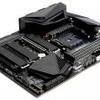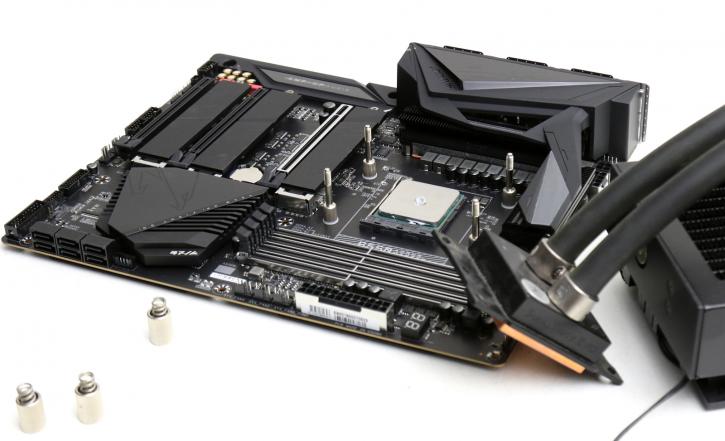Final Words & Conclusion
Conclusion
Gigabyte's B550 Aorus Master is a bit of a black sheep among all white ones, it's a motherboard that sits in de budget range but costs 279 USD. That's contradictory, however, truth be told it is a little gem. The board managed to impress me all the way. I mean the performance among X570 and B550 is simply put the same with minor differences here and there. For B550 typically a lot of features are stripped away, and with some clever tweaks, Gigabyte managed to put 3x M2 on there, 2.5 Gbps ethernet, WIFI6 with AX and Bluetooth, support for the highest clocked DDR4 modules (not that we'd recommend you that) and then heaps of functionality.
The Achilles heel is splitting up that graphics slot towards an x8 lanes one to make all the M2 pleasure possible. realistically even at x8 lanes, you're not going to flood that graphics slots as you'd need extreme SLI or Crossfire to do so. So yeah, I'm cool with that as even with our used GeForce RTX 2080 Ti the performance between X570 and this B550 is pretty much similar. So what's the big difference between X570 and B550 then? Well, in this specific design everything linked to the chipset chip is PCIe Gen 3.0 based, which includes the interlink between the chipset and CPU. There's still heaps of USB 3.0 available so again we do not see any problems there.
All the features make this board really nice, the motherboard also got a bump upwards to AX WIFI (WIFI6) and thus that 2.5G Ethernet jack. Then the VRM design, I mean damn. It has has been beefed up to 16 phases in total (not doubled up) with 70A power stages. We barely reached 50 Degrees C there. Impressive.
DDR4 Memory
Memory compatibility should not and likely will not be an issue as long as you stick to recently released DIMMs. I'll keep repeating this, but there are some really good Ryzen optimized kits out there. With Ryzen Generation 3 you can go higher in DDR4 clock frequency if you want to. We advise that up-to 3600 MHz, CL16 is fine, after that frequency value a 2:1 divider kicks in, and that can have an effect on the Infinity Fabric bandwidth, inter-core CCX bandwidth. We see no reason for faster DDR4 memory anyways, it's expensive and does not bring in added perf, much like what you see on Intel platforms as well.
Power consumption
With Ryzen 3000 processors now fabbed at 7nm, you may see some interesting energy efficiency. now we used a 12 core 3900X on B550 which is a little excessive I agree. The load values are excellent. The 3900X on B550 did show 60 Watts idle load, ergo read my previous statement on the motherboard. The load values with 12 cores stressed topped 215 Watts (entire PC). So yeah, it's all good there.
Performance & tweaking
Your motherboard will not be a restriction for tweaking and overclocking, the processors and ASIC quality alongside cooling these days are the more important factor.The original Ryzen series from 2017 revealed clocks in the 3900~4000 MHz range on all cores. For Ryzen 2000 / Zen+ that was a notch higher. Ryzen 3000 seems to take an all-core clock of 4300~4400 MHz at best. Ryzen 7 3700X was able to reach a stable 4400 MHz, but that was on proper liquid cooling and really absolutely the maximum. If you tweak to the maximum, likely 1.425v~1.450v is needed for a stable 4.3 GHz on all cores. The thing is, and I have been thinking about this for a long time, I would not recommend overclocking and tweaking. These processors by themselves can boost 1 or 2 cores to 4500, 4600 and, on the 16-core part, even 4.7 GHz. So while the rest of the cores will be binned slower, that's where you get your extra game performance. The positives of an all-core 4400 Mhz would not outweigh the positives of the default high Turbo clocks. It is something to think about for sure. At least you can try and see what works best for you. But the binned clock recipe that AMD has applied to the processors at default likely will work out the best in most scenarios, including power consumption. This is going to be a generic and general consensus for all many-core processors really.
Final words
Gigabyte offers an expensive but superb B550 motherboard with the Aorus Master. Every PCIe lane that was available has been rerouted and brought to use. The trick to get to 3x M2 SSDs is an x8 link on graphics, it's the one thing you'll need to forfeit on. But believe me, it's just not an issue for your gaming performance. Next to a proper looking motherboard (with very little RGB I might add) you also reap the benefits of 2.5G Ethernet and AX WIFI. The audio is Realtek 1220 based backed with WIMA capacitors. Next to that, you'll have an abundance of USB 3.2 connectivity at your disposal making this board really feature-rich. Of course, the VRM design is impressive, even after 15 minutes of 100% load on a 12-core processor I could place my hand on the VRM heatsink, it remains luke-warm. The overall performance is in line with X570, and memory support is great. Remember my remarks on frequency though, your sweet spot is two DIMMs at 3200 MHz / CL14 or 3600 MHz CL16. With B550 AMD still allowed partial PCIe Gen 4.0 support, which is great to see.
In closing, we can do nothing else other then recommending this board if the features tick tickle your premium wish senses. The price for a B series motherboard of course is rather intense and thus the cost of ownership for a mainstream desktop series processor, however, adds up. Of course, you'll spot 100 USD B550 motherboards in the market as well. They will perform just as well but will have fewer features and a lesser VRM design. Choices choices .. but it's good to have them. The Gigabyte B550 Aorus Master overall however as hardware, we can wholeheartedly recommend. We can only describe this motherboard weirdly as a truly premium offering in a budget targeted range.
Handy related downloads:
- Sign up to receive a notification when we publish a new article
- Or go back to Guru3D's front page



